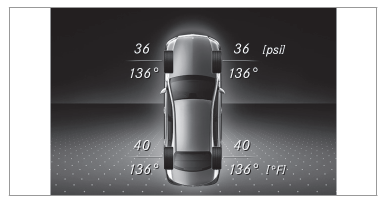Mercedes-Benz C-Class (W205) 2015 - 2021 Owners Manual: Tire pressure monitoring system
Function of the tire pressure monitoring system
The system checks the tire pressure and the tire temperature of the tires installed on the vehicle by means of a tire pressure sensor. New tire pressure sensors, e.g. in winter tires, are automatically taught-in during the first journey they are used. The tire pressure and the tire temperature appear in the multifunction display. If there is a substantial pressure loss or if the tire temperature is excessive, you will be warned in the following ways:
The tire pressure monitoring system is only an aid. It is the driver's responsibility to set the tire pressure to the recommended cold tire pressure suitable for the operating situation. Set the tire pressure for cold tires using a tire pressure gauge. Note that the correct tire pressure for the current operating situation must first be taught-in to the tire pressure monitoring system. In most cases, the tire pressure monitoring system will automatically update the new reference values after you have changed the tire pressure. You can, however, also update the reference values by restarting the tire pressure monitoring system manually. System limitations The system may be impaired or may not function in the following situations:
Make sure to observe the following further related subject:
Checking the tire pressure with the tire pressure monitoring system Requirements:
On-board computer: Service → Tires One of the following displays appears:
The values displayed in the multifunction display may deviate from those of the tire pressure gauge as they refer to sea level. At high altitudes, the tire pressure value indicated by a pressure gauge are higher than those shown by the on-board computer. In this case, do not reduce the tire pressure. Make sure to observe the following further related subject:
Restarting the tire pressure monitoring system Requirements:
Restart the tire pressure monitoring system in the following situations:
On-board computer: Service → Tires
Make sure to observe the following further related subject:
Radio equipment approval of the tire pressure monitoring system Radio equipment approval numbers
Further information on the declaration of conformity for wireless vehicle components. |
See More:
Mercedes-Benz C-Class (W205) 2015 - 2021 Owners Manual > Stowage areas: Hooking in the parcel net
WARNING Risk of injury due to objects being stowed incorrectly If you do not adequately stow objects in the vehicle interior, they could slip or be tossed around and thereby strike vehicle occupants. In addition, cup holders, open stowage spaces and mobile phone brackets cannot always restrain the ...
Mercedes-Benz C-Class (W205) 2015 - 2021 Owners Manual
- At a glance
- Digital Operator's Manual
- General notes
- Occupant safety
- Opening and closing
- Seats and stowing
- Light and visibility
- Climate control
- Driving and parking
- Instrument Display and on-board computer
- Voice Control System
- Multimedia system
- Maintenance and care
- Breakdown assistance
- Wheels and tires
- Technical data
- Display messages and warning/indicator lamps



